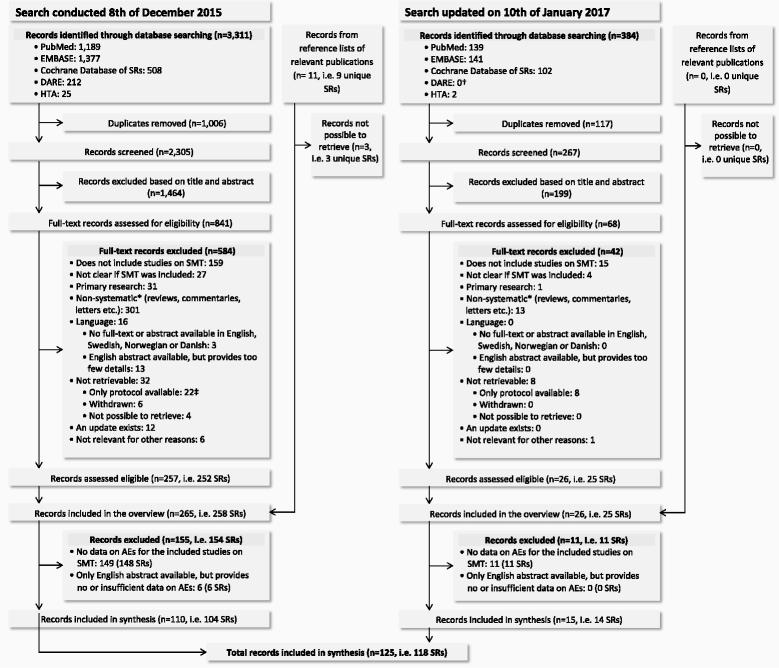The risk associated with spinal manipulation: an overview of reviews
- PMID: 28340595
- PMCID: PMC5366149
- DOI: 10.1186/s13643-017-0458-y
The risk associated with spinal manipulation: an overview of reviews
Abstract
Background: Spinal manipulative therapy (SMT) is a widely used manual treatment, but many reviews exist with conflicting conclusions about the safety of SMT. We performed an overview of reviews to elucidate and quantify the risk of serious adverse events (SAEs) associated with SMT.
Methods: We searched five electronic databases from inception to December 8, 2015. We included reviews on any type of studies, patients, and SMT technique. Our primary outcome was SAEs. Quality of the included reviews was assessed using a measurement tool to assess systematic reviews (AMSTAR). Since there were insufficient data for calculating incidence rates of SAEs, we used an alternative approach; the conclusions regarding safety of SMT were extracted for each review, and the communicated opinion were judged by two reviewers independently as safe, harmful, or neutral/unclear. Risk ratios (RRs) of a review communicating that SMT is safe and meeting the requirements for each AMSTAR item, were calculated.
Results: We identified 283 eligible reviews, but only 118 provided data for synthesis. The most frequently described adverse events (AEs) were stroke, headache, and vertebral artery dissection. Fifty-four reviews (46%) expressed that SMT is safe, 15 (13%) expressed that SMT is harmful, and 49 reviews (42%) were neutral or unclear. Thirteen reviews reported incidence estimates for SAEs, roughly ranging from 1 in 20,000 to 1 in 250,000,000 manipulations. Low methodological quality was present, with a median of 4 of 11 AMSTAR items met (interquartile range, 3 to 6). Reviews meeting the requirements for each of the AMSTAR items (i.e. good internal validity) had a higher chance of expressing that SMT is safe.
Conclusions: It is currently not possible to provide an overall conclusion about the safety of SMT; however, the types of SAEs reported can indeed be significant, sustaining that some risk is present. High quality research and consistent reporting of AEs and SAEs are needed.
Systematic review registration: PROSPERO CRD42015030068 .
Figures

Similar articles
-
Electronic cigarettes for smoking cessation.Cochrane Database Syst Rev. 2021 Sep 14;9(9):CD010216. doi: 10.1002/14651858.CD010216.pub6. Cochrane Database Syst Rev. 2021. Update in: Cochrane Database Syst Rev. 2022 Nov 17;11:CD010216. doi: 10.1002/14651858.CD010216.pub7. PMID: 34519354 Free PMC article. Updated.
-
Drugs for preventing postoperative nausea and vomiting in adults after general anaesthesia: a network meta-analysis.Cochrane Database Syst Rev. 2020 Oct 19;10(10):CD012859. doi: 10.1002/14651858.CD012859.pub2. Cochrane Database Syst Rev. 2020. PMID: 33075160 Free PMC article.
-
Electronic cigarettes for smoking cessation.Cochrane Database Syst Rev. 2022 Nov 17;11(11):CD010216. doi: 10.1002/14651858.CD010216.pub7. Cochrane Database Syst Rev. 2022. Update in: Cochrane Database Syst Rev. 2024 Jan 8;1:CD010216. doi: 10.1002/14651858.CD010216.pub8. PMID: 36384212 Free PMC article. Updated.
-
A rapid and systematic review of the clinical effectiveness and cost-effectiveness of topotecan for ovarian cancer.Health Technol Assess. 2001;5(28):1-110. doi: 10.3310/hta5280. Health Technol Assess. 2001. PMID: 11701100
-
Physical activity and exercise for chronic pain in adults: an overview of Cochrane Reviews.Cochrane Database Syst Rev. 2017 Apr 24;4(4):CD011279. doi: 10.1002/14651858.CD011279.pub3. Cochrane Database Syst Rev. 2017. PMID: 28436583 Free PMC article.
Cited by
-
A taxonomy of risk-associated alternative health practices: A Delphi study.Health Soc Care Community. 2022 May;30(3):1163-1181. doi: 10.1111/hsc.13386. Epub 2021 May 26. Health Soc Care Community. 2022. PMID: 34041822 Free PMC article.
-
[Atlas block and alar ligament lesion-Underestimated or overrated?].Schmerz. 2024 Oct;38(5):352-358. doi: 10.1007/s00482-023-00731-8. Epub 2023 Jul 19. Schmerz. 2024. PMID: 37468617 Free PMC article. Review. German.
-
Adverse events following cervical manipulative therapy: consensus on classification among Dutch medical specialists, manual therapists, and patients.J Man Manip Ther. 2017 Dec;25(5):279-287. doi: 10.1080/10669817.2017.1332556. Epub 2017 May 31. J Man Manip Ther. 2017. PMID: 29449770 Free PMC article.
-
The Effect of Electronical Film on the Anxiety of Patients Candidate for Lumbar Disc Surgery.Iran J Nurs Midwifery Res. 2019 Sep-Oct;24(5):330-336. doi: 10.4103/ijnmr.IJNMR_233_18. Iran J Nurs Midwifery Res. 2019. PMID: 31516517 Free PMC article.
-
Efficacy and safety of musculoskeletal manipulations in elderly population with musculoskeletal disorders: a systematic review.BMJ Open. 2025 Jun 26;15(6):e088655. doi: 10.1136/bmjopen-2024-088655. BMJ Open. 2025. PMID: 40578898 Free PMC article.
References
-
- Brodeur R. The audible release associated with joint manipulation. J Manipulative Physiol Ther. 1995;18:155–164. - PubMed
Publication types
MeSH terms
LinkOut - more resources
Full Text Sources
Other Literature Sources
Molecular Biology Databases
Miscellaneous

